
An autogyro, or gyroplane, is a class of rotorcraft that uses an unpowered rotor in free autorotation to develop lift. While similar to a helicopter rotor in appearance, the autogyro's unpowered rotor disc must have air flowing upward across it to make it rotate.

The MBB/Kawasaki BK 117 is a twin-engined light utility–transport helicopter. It was jointly developed and manufactured by Messerschmitt-Bölkow-Blohm (MBB) of Germany and Kawasaki of Japan. MBB was later purchased by Daimler-Benz and eventually became a part of Eurocopter, which was later rebranded as Airbus Helicopters.

The Sikorsky S-76 is a medium-size commercial utility helicopter designed and produced by the American helicopter manufacturer Sikorsky Aircraft. It is the company's first helicopter specifically developed for the civilian market.
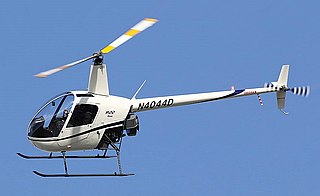
The Robinson R22 is a two-seat, two-bladed, single-engined, light utility helicopter manufactured by Robinson Helicopter Company. It was designed in 1973 by Frank D. Robinson, and has been in production since 1979.
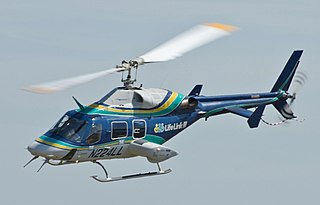
The Bell 222 is an American twin-engine light helicopter built by Bell Helicopter. The Bell 230 is an improved development with different engines and other minor changes.
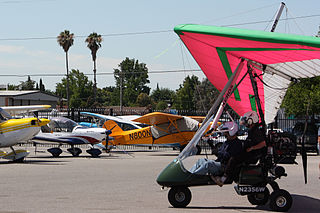
A light-sport aircraft (LSA), or light sport aircraft, is a fairly new category of small, lightweight aircraft that are simple to fly. LSAs tend to be heavier and more sophisticated than ultralight aircraft, but LSA restrictions on weight and performance separates the category from established GA aircraft. There is no standard worldwide description of an LSA.

The Schweizer S300 series family of light utility helicopters was originally produced by Hughes Helicopters, as a development of the Hughes 269. Later manufactured by Schweizer Aircraft, and currently produced by Schweizer RSG, the basic design has been in production for over 50 years. The single, three-bladed main rotor and piston-powered S300 is mostly used as a cost-effective platform for training and agriculture.

The Piper PA-31 Navajo is a family of twin-engined utility aircraft designed and built by Piper Aircraft for small cargo and feeder airlines, and as a corporate aircraft. Production ran from 1967 to 1984. It was license-built in a number of Latin American countries.

The Hughes TH-55 Osage is a piston-powered light training helicopter produced for the United States Army. It was also produced as the Model 269 family of light utility helicopters, some of which were marketed as the Model 300. The Model 300C was produced and further developed by Schweizer after 1983.

A gyrodyne is a type of VTOL aircraft with a helicopter rotor-like system that is driven by its engine for takeoff and landing only, and includes one or more conventional propeller or jet engines to provide forward thrust during cruising flight. During forward flight the rotor is unpowered and free-spinning, like an autogyro, and lift is provided by a combination of the rotor and conventional wings. The gyrodyne is one of a number of similar concepts which attempt to combine helicopter-like low-speed performance with conventional fixed-wing high-speeds, including tiltrotors and tiltwings.
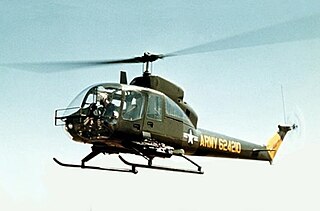
The Fairchild Hiller FH-1100 is a single-engine, single two-bladed rotor, light helicopter designed and produced by the American aircraft manufacturer Fairchild Hiller.

The EurocopterAS355 Écureuil 2 is a twin-engine light utility helicopter developed and originally manufactured by Aérospatiale in France

The McCulloch J-2 was a small, two-seat autogyro with an enclosed cabin, one of only three designs of this type of aircraft to receive a type certificate in the United States. It was built by McCulloch Aircraft Corporation.

The Enstrom F-28 and 280 are a family of small, light piston engine powered helicopters produced by the Enstrom Helicopter Corporation.

The Rockwell Commander 112 is an American four-seat single-engined general aviation aircraft designed and built by North American Rockwell starting in 1972. In 1976, they introduced the turbocharged version 112TC and mounting a larger engine with other minor improvements they introduced the Rockwell Commander 114. A total of approximately 1,300 examples of all models were produced before the production line shut down in 1980. In 1981, the type certificate owner was Gulfstream Aerospace, but that company had no interest in single-engine piston production.
The Honeywell HTS900 is an American turboshaft engine produced by Honeywell Aerospace. A growth version of the LTS101 which it is designed to replace, the HTS900 is in the 1,000 shp (745 kW) class.
The Lycoming O-233 is a four-cylinder, air-cooled, horizontally opposed piston aircraft engine that was built by Lycoming Engines between 1940 and 1944.
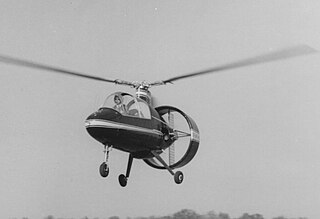
The Avian 2/180 Gyroplane was a two-seat, single-engine autogyro built in Canada in the 1960s. Several prototypes were built but production was not achieved.
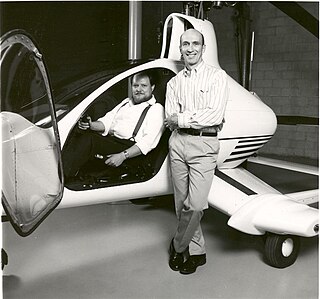
Skyworks Aeronautics Corp., formerly Groen Brothers Aviation, Inc., Groen Aeronautics Corporation and Skyworks Global, is an American autogyro research and development company based in Chicago. The company was founded in 1986 by David Groen and his late brother Jay Groen in Salt Lake City, Utah. David Groen remains as Senior Advisor.
The Calumet Snobird Explorer was an American autogyro designed and produced by Calumet Motorsports of Lansing, Illinois, introduced in May 1997. Now out of production, when it was available, the aircraft was supplied as a kit for amateur construction.

















